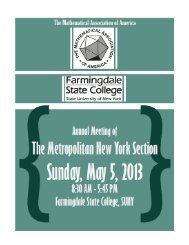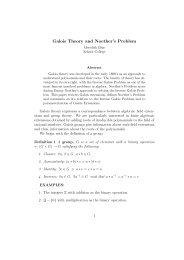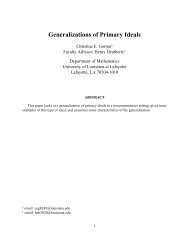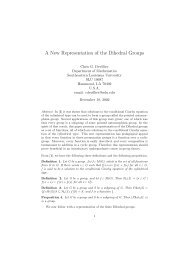Program - MAA Sections - Mathematical Association of America
Program - MAA Sections - Mathematical Association of America
Program - MAA Sections - Mathematical Association of America
Create successful ePaper yourself
Turn your PDF publications into a flip-book with our unique Google optimized e-Paper software.
Abstract Number: 31. Concept maps provide an external representation <strong>of</strong> students internal<br />
knowledge structures. In particular, concept mapping developed originally by Novak builds <strong>of</strong>f the<br />
ideas <strong>of</strong> Ausabel and Deese concerning linkages in cognitive structures. This talk will (1) examine<br />
the structure <strong>of</strong> various types <strong>of</strong> concept maps, (2) discuss instructions and training and (3) provide<br />
examples <strong>of</strong> concept maps developed by students in an elementary linear algebra course.<br />
Tiling Deficient Boards with Trominos<br />
Jennifer R Picucci<br />
Student, Ashland Univ<br />
Abstract Number: 32. On an n × n board with one square removed can it be tiled using right<br />
trominos? Does n have to be odd or even? Are there any boards that cannot be tiled besides those<br />
not divisible by 3? These and more questions will be answered when looking at n × n boards with<br />
one square removed as n becomes larger and larger.<br />
Overtime<br />
Nicole E Thompson<br />
Student, Ashland Univ<br />
Abstract Number: 33. Given the option, what would be the optimal method <strong>of</strong> overtime in<br />
football? You would want to choose a method in which the coin toss has minimal effects on the<br />
outcome <strong>of</strong> the game and where the probability <strong>of</strong> each team winning is as close to equal as possible.<br />
We will explore two methods <strong>of</strong> overtime to determine which method would give the best<br />
probabilities for each team.<br />
Saturday 10:20 – 10:35<br />
Theoretical Development <strong>of</strong> a Self-Lubricating Porous Bearing<br />
Joshua Johnston<br />
Graduate Student, University <strong>of</strong> Akron<br />
Abstract Number: 34. This presentation will discuss the utilization <strong>of</strong> the Brinkman-extended<br />
Darcy equations and a stress jump boundary condition to derive a modified Reynolds equation to<br />
model a new type <strong>of</strong> self-lubricating bearing. The design in question features a porous slider bearing<br />
and a pressurized reservoir that acts as a natural pump.<br />
Ideal-divisor Graphs <strong>of</strong> Commutative Rings<br />
Michael T McGowan<br />
Student, John Carroll Univ<br />
Abstract Number: 35. Given a commutative ring R, one can construct the zero-divisor graph <strong>of</strong> R<br />
by letting vertices correspond to non-trivial zero-divisors and by placing an edge between two<br />
vertices whose product is 0. This concept can be generalized to “ideal-divisor” graphs, and many<br />
interesting properties can be discovered, especially when examining the graphs <strong>of</strong> direct products <strong>of</strong><br />
various rings.<br />
The Steiner Problem on the Wide Cone<br />
Colleen S Hughes<br />
Student, Denison Univ<br />
Abstract Number: 36. The general Steiner problem is a type <strong>of</strong> minimization problem that states:<br />
Given a set <strong>of</strong> n points in the plane, what is the shortest length network which will connect all n<br />
points? This shortest network for a set <strong>of</strong> points is called a Steiner network. A special case <strong>of</strong> the

















